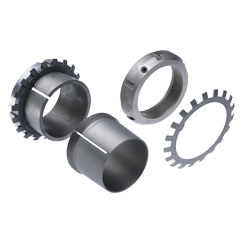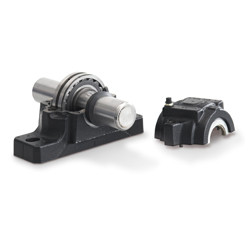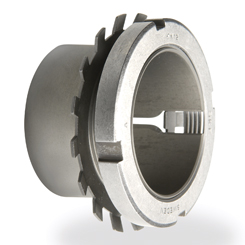Clamping Sleeves and Extracting Sleeves




Clamping sleeves are the most commonly used fixing elements for roller bearings with tapered boring on a cylindrical fitting. This means they can be used on both smooth-surfaced and profiled shafts. They are easy to mount and do not need to be fixed to the shaft. The tapered sleeve is pulled in between the inner ring and the shaft using the appropriate screw nut. After mounting, the nut is fixed in place using the tab washer, whereby a tab of the washer is pushed into a groove of the screw nut. In the case of larger diameters, a safety bracket replaces the tab washer.
The clamping sleeves are available both for metric and imperial shaft dimensions. Combined with smooth-surfaced shafts, the bearing can be fixed to the shaft in the desired place. In the case of a profiled shaft, a shoring ring must be used to fix the axial position of the bearing exactly.
Unlike clamping sleeves, extracting sleeves require an external mounting force in order to press them between the internal bearing ring and the shaft. For this, the bearing requires a shaft shoulder as an axial shoring. In general, this axial mounting force is created by a shaft nut. After mounting, the extracting sleeve must be fixed in position.
As the mounting forces are high with larger diameters, hydraulic or annular piston nuts are favoured. These are two-part, reciprocally sealed, ring-shaped components, which are pushed together when mounted using hydraulic pressure. Each component has an internal thread with which it is fastened on to the shaft. The other part is pushed against the extracting sleeve using the annular piston and is thereby pressed between the inner ring and the shaft.
For diameters of about 200mm or more, both clamping and extracting sleeves with oiled nuts should be used for the best possible results. This means that a thin film of oil can be put between the shafts and the sleeve surfaces, which allows the components to slide across each other more easily.
Shaft nuts
Shaft nuts are used for fixing bearings and other machine components to the shaft. Furthermore, they make it easier to install bearings on tapered shaft journals and to remove bearings from extracting sleeves. Depending on what they are to be used for, shaft nuts are called locking nuts or dismantling nuts. Shaft nuts in their various forms differ according to the following types of fixing to the shaft: tab washers, safety brackets, clamping pins, shims and locking pins.
Bearing Housing
Together with the appropriate roller bearing, housings make up economical, replaceable bearing units and meet the requirements of a maintenance-friendly design . The most common housing designs are: pillow block housing, duplex bearing housing and flanged housing.
Pillow block housings are intended for the installation of spherical roller bearings, self-aligning ball bearings and CARB bearings. They can be fixed directly to smooth-surfaced or profiled shafts using clamping sleeves. This type of housing can also be used as a fixed bearing if a stationary ring is attached to either side.
Duplex bearing housings are partitioned and have two bearing seats. The bearing seats are machined in a single setting and are therefore perfectly concentric. This makes it possible to use rigid bearings and has a positive effect on concentricity, and also ensures smoother operation.
The two bearing seats have different widths. Therefore, a paired bearing can be installed on the side with the wider bearing seat.
The partitioned housing can therefore house different types of roller bearings, such as deep groove ball bearings, angular ball bearings and cylindrical roller bearings, combined in different ways.
Flanged housings: There are two different types of flanged housings. In general, this type of housing is manufactured in two versions: one type is intended for use as a permanent end bearing housing with an end cover and the other as a housing which is opened at both ends for a shaft to run through. For flanged housings there are different spacers and stationary rings available.